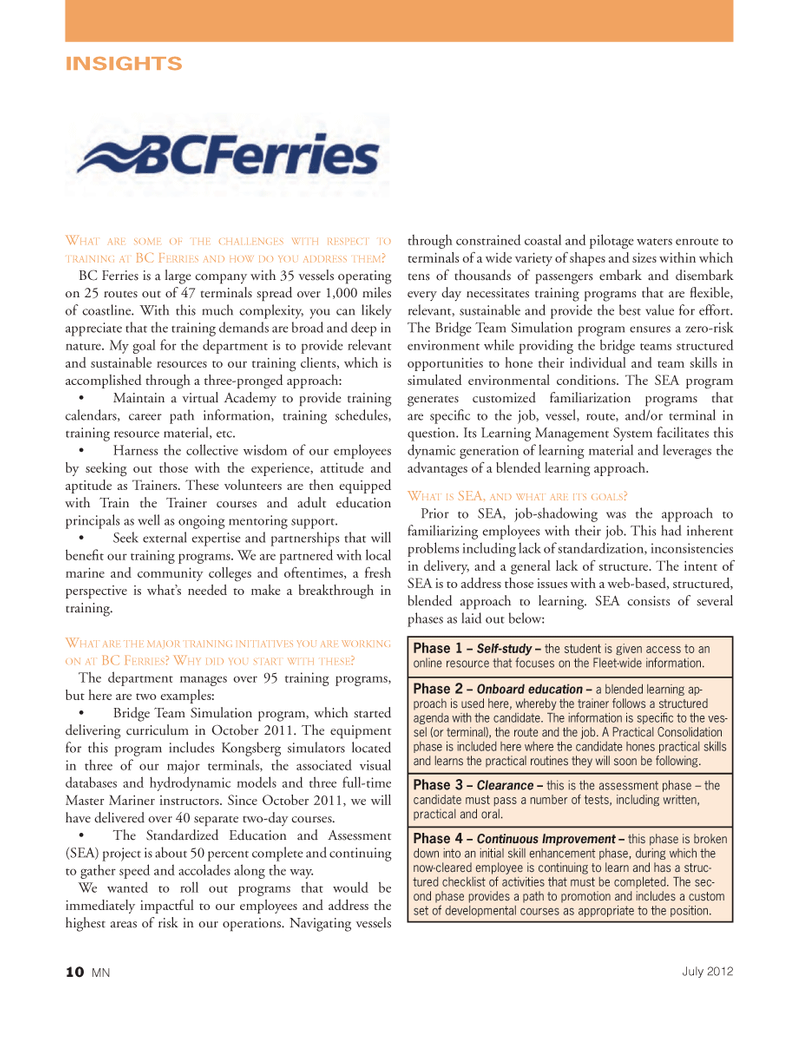
Page 10: of Marine News Magazine (July 2012)
Propulsion Technology
Read this page in Pdf, Flash or Html5 edition of July 2012 Marine News Magazine
WHAT ARE SOME OF THE CHALLENGES WITH RESPECT TO TRAINING AT BC FERRIES AND HOW DO YOU ADDRESS THEM? BC Ferries is a large company with 35 vessels operating on 25 routes out of 47 terminals spread over 1,000 miles of coastline. With this much complexity, you can likely appreciate that the training demands are broad and deep in nature. My goal for the department is to provide relevant and sustainable resources to our training clients, which is accomplished through a three-pronged approach: Maintain a virtual Academy to provide training calendars, career path information, training schedules, training resource material, etc. Harness the collective wisdom of our employees by seeking out those with the experience, attitude and aptitude as Trainers. These volunteers are then equipped with Train the Trainer courses and adult education principals as well as ongoing mentoring support. Seek external expertise and partnerships that will bene t our training programs. We are partnered with local marine and community colleges and oftentimes, a fresh perspective is what?s needed to make a breakthrough in training. WHAT ARE THE MAJOR TRAINING INITIATIVES YOU ARE WORKING ON AT BC FERRIES? WHY DID YOU START WITH THESE? The department manages over 95 training programs, but here are two examples: Bridge Team Simulation program, which started delivering curriculum in October 2011. The equipment for this program includes Kongsberg simulators located in three of our major terminals, the associated visual databases and hydrodynamic models and three full-time Master Mariner instructors. Since October 2011, we will have delivered over 40 separate two-day courses. The Standardized Education and Assessment (SEA) project is about 50 percent complete and continuing to gather speed and accolades along the way. We wanted to roll out programs that would be immediately impactful to our employees and address the highest areas of risk in our operations. Navigating vessels through constrained coastal and pilotage waters enroute to terminals of a wide variety of shapes and sizes within which tens of thousands of passengers embark and disembark every day necessitates training programs that are exible, relevant, sustainable and provide the best value for effort. The Bridge Team Simulation program ensures a zero-risk environment while providing the bridge teams structured opportunities to hone their individual and team skills in simulated environmental conditions. The SEA program generates customized familiarization programs that are speci c to the job, vessel, route, and/or terminal in question. Its Learning Management System facilitates this dynamic generation of learning material and leverages the advantages of a blended learning approach. WHAT IS SEA, AND WHAT ARE ITS GOALS ? Prior to SEA, job-shadowing was the approach to familiarizing employees with their job. This had inherent problems including lack of standardization, inconsistencies in delivery, and a general lack of structure. The intent of SEA is to address those issues with a web-based, structured, blended approach to learning. SEA consists of several phases as laid out below: INSIGHTSPhase 1 ? Self-study ? the student is given access to an online resource that focuses on the Fleet-wide information. Phase 2 ? Onboard education ? a blended learning ap-proach is used here, whereby the trainer follows a structured agenda with the candidate. The information is speciÞ c to the ves- sel (or terminal), the route and the job. A Practical Consolidation phase is included here where the candidate hones practical skills and learns the practical routines they will soon be following. Phase 3 ? Clearance ? this is the assessment phase Ð the candidate must pass a number of tests, including written, practical and oral. Phase 4 ? Continuous Improvement ? this phase is broken down into an initial skill enhancement phase, during which the now-cleared employee is continuing to learn and has a struc- tured checklist of activities that must be completed. The sec- ond phase provides a path to promotion and includes a custom set of developmental courses as appropriate to the position. 10 MNJuly 2012

 9
9

 11
11
